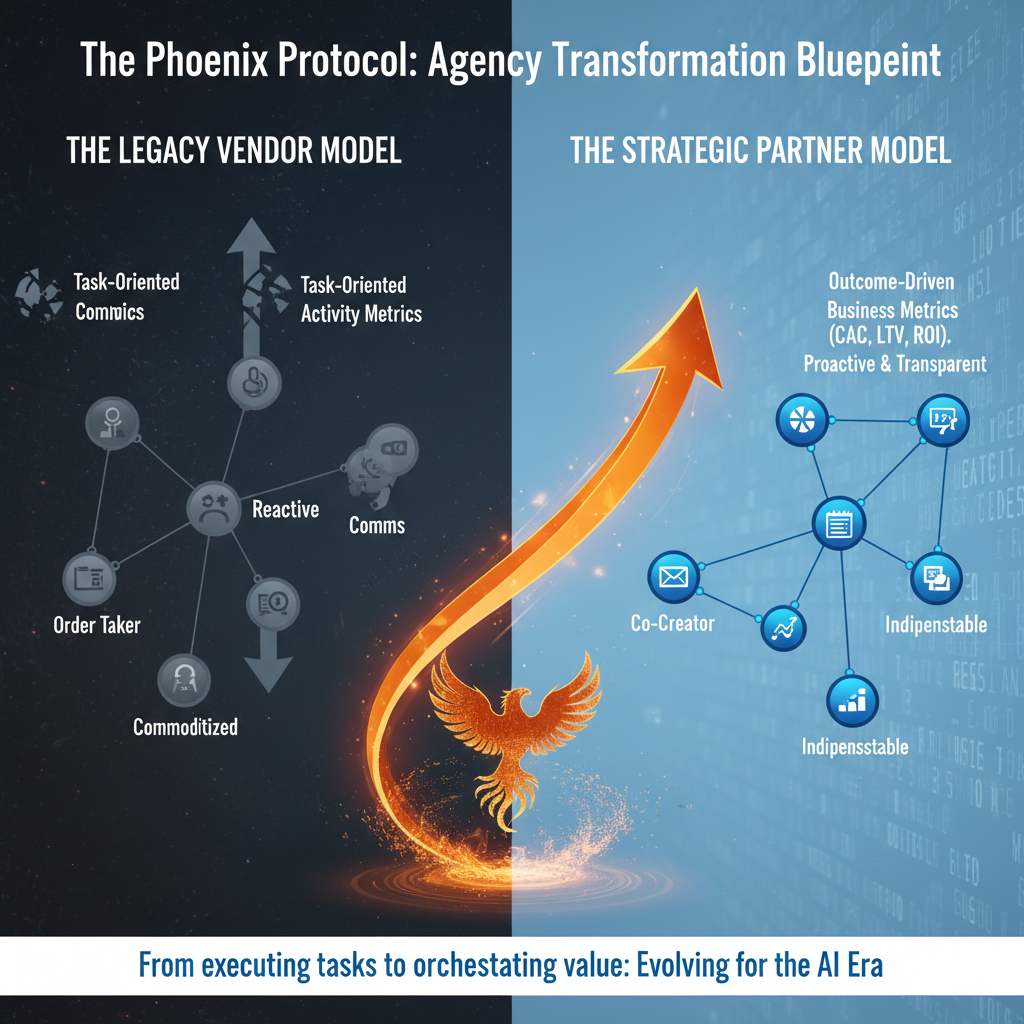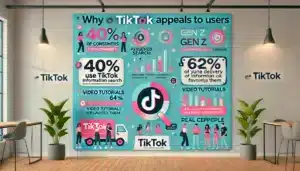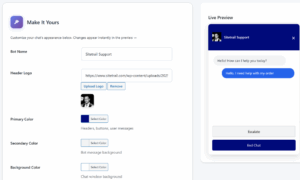The marketing industry is currently navigating a pincer movement of unprecedented force. On one flank, a technological revolution, spearheaded by Artificial Intelligence, is fundamentally rewriting the rules of customer engagement, content creation, and strategic planning. On the other, a concurrent crisis of confidence is eroding the foundations of the traditional agency-client model, a partnership long plagued by misaligned expectations and a persistent struggle to demonstrate tangible value.
Survival and success in this new matrix demand more than just adopting novel tools; they require a complete re-architecting of the agency-client relationship itself. This report will first map the new strategic battlegrounds defined by AI and privacy. It will then diagnose the critical fissures in modern agency relationships before prescribing a “Phoenix Protocol”—a framework for agencies to rise from the ashes of the old vendor model as indispensable strategic partners. Finally, it will address the most subtle but significant new threat: controlling a brand’s narrative in an ecosystem increasingly curated by AI.
The New Strategic Battlegrounds: Key Digital Marketing Shifts for 2026
The strategic context for 2026 is being shaped by interconnected technological and regulatory forces. These are not isolated trends but a confluence of shifts that collectively elevate the standard for strategic competence, demanding a more integrated and sophisticated approach from both brands and their agency partners.
The AI Mandate: From Automation to Autonomous Strategy
Artificial Intelligence is no longer an experimental line item on an innovation budget; it has become the new operating system for marketing. Data indicates a rapid maturation from pilot programs to daily dependence, with over half (56%) of marketing organizations actively implementing AI. The most common applications have moved beyond novelty to become core functions: 51% of teams use AI to optimize content, 50% for content creation, and 41% for data analysis.
The trajectory of this trend points decisively beyond mere task automation. The real transformation lies in AI’s growing role in strategic functions. Predictive analytics are now being used to forecast consumer behavior, identify high-potential customer segments, and enable more precise resource allocation before a campaign even launches. This creates a “high-velocity learning lab” where campaign variables can be tested, analyzed, and optimized in real-time, compressing feedback loops from weeks to hours. This acceleration places immense pressure on agencies to deliver results with a speed and precision that were previously unimaginable.
A critical component of this shift is the redefinition of search. The era of “10 blue links” is giving way to conversational, synthesized answers generated by AI, a trend known as Answer Engine Optimization (AEO). This has given rise to a new and essential discipline: Generative Engine Optimization (GEO). The focus of GEO is to structure content in a way that is “snippet-ready”—authoritative, clearly formatted, and semantically rich enough to be cited directly by AI models in their generated responses.
The Trust Economy: Thriving in a Privacy-First, Post-Cookie World
In the marketing landscape of 2026, privacy is not a feature but the non-negotiable centerpiece of strategy. An overwhelming 94% of marketers now recognize that customers will not purchase from brands that fail to properly protect their data. This sentiment is reinforced by a complex and expanding web of regulation, with new privacy laws continuously coming into effect across the United States and globally.
The deprecation of third-party cookies by major platforms has catalyzed a necessary and overdue strategic pivot. The future of effective marketing belongs to organizations that can master the collection and ethical use of first-party data (information collected directly from customers) and zero-party data (information that customers intentionally and proactively share). This is not merely a technical challenge of implementing new consent management platforms; it represents a fundamental shift in the brand-customer relationship. It necessitates a clear value exchange, where brands and their agencies must provide tangible benefits—such as deep personalization, exclusive access, or enhanced user experiences—to earn the data that customers willingly share.
This reframes the entire conversation around data governance. Privacy compliance is no longer a defensive, cost-center activity focused on avoiding fines. It is a proactive, strategic investment in building trust. With 84% of users reporting higher loyalty to companies with strong security controls, a robust privacy framework becomes a powerful competitive advantage. Agencies must lead this conversation, positioning data governance not as a constraint, but as a critical enabler of enhanced customer loyalty and, ultimately, greater Customer Lifetime Value (CLV).
The Convergence of Experience: Hyper-Personalization and the Omnichannel Imperative
Customer expectations for personalized experiences have reached an apex, with 81% of consumers stating they prefer companies that offer them. Yet, a stark disconnect exists between expectation and reality. A 2023 Forrester survey found that while most brands attempt personalization, only 19% of consumers rated their experiences as “good,” and a staggering 0% rated them as “excellent”. This gap between demand and delivery represents one of the single largest opportunities for brands to differentiate themselves.
AI is the engine that finally makes true hyper-personalization—delivering uniquely relevant content at the right time to the right individual—scalable. This capability extends far beyond inserting a customer’s first name into an email subject line. It involves leveraging real-time behavioral data to dynamically adapt content, product recommendations, and entire user journeys across all touchpoints. This experience must be seamless and consistent, whether a customer is engaging with an augmented reality feature in a physical store, browsing on a mobile app, or receiving a follow-up email. This demand for a unified journey inherently forces the improvement and integration of omnichannel marketing efforts, breaking down the silos that have traditionally separated digital and physical experiences.
The convergence of these three macro-trends—AI, privacy, and personalization—creates a strategic trilemma. AI requires vast amounts of high-quality data to power the sophisticated personalization that customers now demand. At the same time, privacy regulations and the end of third-party cookies are severely restricting the broad, passive data collection methods that marketers once relied upon. The only viable path forward is a strategic commitment to earning first-party and zero-party data. This elevates the role of the marketing agency from a mere media buyer or content creator to a “value exchange architect.” The most critical strategic question an agency must now help a client answer is no longer “Where should we place our ads?” but rather, “What value can we provide that is so compelling our customers will want to give us their data?” This profound shift moves the agency’s focus from tactical execution to foundational business strategy.
The Great Disconnect: Diagnosing the Core Fissures in Agency-Client Relationships

The disruptive trends reshaping the marketing landscape are also amplifying the long-standing frictions within the agency-client relationship. What were once manageable annoyances are now becoming critical points of failure, as client expectations, supercharged by the promise of new technology, collide with outdated agency operating models.
The Communication Chasm: Why Misaligned Expectations Erode Trust
“Bad communication” remains one of the most cited reasons for client churn, a fundamental breakdown that poisons partnerships. This manifests in myriad ways: slow response times to inquiries, a lack of proactive updates on campaign progress, and a failure to provide clear, insightful reports. The problem is often rooted in the very first conversation, with many agencies failing to ask the deep, probing questions required to truly understand what “success” means to the client, instead making dangerous assumptions.
In the AI era, this communication chasm widens into a canyon. Clients read about the potential for AI to generate instant results and naturally expect their agencies to deliver them. When an agency is still grappling with basic project management hygiene, inefficient task management, and fragmented workflows, the gap between client expectation and agency reality becomes untenable. This friction is further exacerbated by a lack of rigorous documentation and formal processes for managing project scope. “Scope creep”—the slow expansion of deliverables without a corresponding adjustment in budget or timeline—leads to uncompensated work, team burnout, and simmering resentment on both sides.
The ROI Reckoning: Moving Beyond Vanity Metrics to Prove Business Impact
The C-suite is under relentless pressure to justify every dollar of expenditure, and the marketing budget is facing unprecedented scrutiny. CEOs and CFOs are no longer interested in marketing reports filled with “vanity metrics” like social media engagement or website traffic. They demand a clear, quantifiable link between marketing activities and the business outcomes the boardroom values most: pipeline growth, profit margins, and customer retention. Despite this clear mandate, a concerning 36% of agencies admit they still struggle to align their efforts with these fundamental business goals.
Agencies that continue to report on activity-based metrics without connecting them to revenue are increasingly viewed as tactical, commoditized, and ultimately, expendable. The modern imperative is to speak the language of finance. This requires a mastery of metrics like Customer Acquisition Cost (CAC), Customer Lifetime Value (CLV), and Return on Ad Spend (ROAS), and the ability to build reporting that traces a clear line from campaign spend to bottom-line impact. The conversation must evolve from “engagement is up 15%” to “this campaign added $240,000 in qualified sales pipeline”.
The Brand-Performance Paradox: Reconciling Short-Term Demands with Long-Term Value
Clients are often caught in a strategic bind, pressured to deliver immediate, measurable wins (the domain of performance marketing) while simultaneously understanding the need to build a strong, resilient brand for long-term, sustainable growth. This is not a new tension, but it has become more acute. High-performing agencies are learning that this is a false dichotomy. They are beginning to blur the lines between brand and performance, using technology and integrated data to build connected, full-funnel strategies that do both.
The challenge for most agencies lies in articulating and measuring the powerful synergy between these two functions. In a privacy-first world, a strong brand that has earned customer trust is a direct prerequisite for gathering the high-quality first-party data needed to fuel effective performance marketing. The agency’s role is to demonstrate this connection. This involves moving beyond simple conversion tracking to incorporate brand lift studies and other methodologies that connect brand-building initiatives to downstream financial impact. By doing so, they can reframe brand spending not as an unmeasurable expense, but as a long-term growth asset with a clear and demonstrable payback period.
These three core fissures—communication, ROI, and the brand-performance divide—are not isolated issues. They are interconnected symptoms of a single, deeper failure: the agency’s inability to evolve its identity from that of a task-oriented vendor to a strategic business partner. A vendor takes orders, focuses on a list of deliverables, and reports on activity metrics. This inevitably leads to the communication chasm because the client’s true goal was never a set of deliverables, but a business outcome. This focus on activity makes it impossible to connect work to business results, leading directly to the ROI reckoning. Finally, a vendor mentality creates the brand-performance paradox by executing campaigns in silos, disconnected from the overarching business strategy that requires both to work in concert. Consequently, the root cause of client churn is a fundamental misalignment of identity. Agencies that continue to define themselves by the services they execute will be commoditized. The agencies that thrive will be those that define themselves by the business problems they solve.
The Phoenix Protocol: A Framework for the Modern Agency Partnership
To bridge the disconnect and thrive in the new marketing matrix, agencies must undergo a fundamental transformation. The Phoenix Protocol is a framework for this evolution, designed to help agencies shed the legacy vendor model and emerge as indispensable strategic partners.
From Vendor to Value Orchestrator: Adopting a C-Suite Mentality
The first and most critical step is an identity shift. Agencies must consciously reposition themselves from service providers to an advisory and orchestration function that directly supports sales, finance, and overall business objectives. This requires developing a level of understanding of the client’s business model, revenue drivers, competitive landscape, and internal pressures that is on par with the client’s own executive team.
To execute this shift, agencies should adopt Account-Based Marketing (ABM) principles not merely as a client service, but as an internal philosophy for collaboration. This begins with conducting thorough, structured assessments at the outset of every engagement to understand not just marketing goals, but broader business challenges and the political dynamics within the client’s organization. Every proposal, report, and strategic recommendation must be framed in the language of the boardroom, explicitly linking marketing activities to revenue generation, margin improvement, and risk mitigation.
Radical Transparency: A System for Data-Driven Trust
Trust is the bedrock of any successful long-term partnership, and in the agency world, it is built through proactive, honest, and data-backed communication. This process must be systematized, moving away from ad-hoc updates and toward a structured framework for transparency. This begins on day one by co-creating a charter that establishes crystal-clear expectations, defines success metrics (KPIs), and formalizes a communication plan.
Key components of this system include:
- A Unified Client Portal: Agencies should implement a centralized, white-label portal that provides clients with 24/7 access to campaign schedules, creative assets for review, and, most importantly, real-time performance dashboards. This grants clients the visibility and sense of control they crave while dramatically reducing the administrative burden of constant email check-ins.
- A Structured Communication Cadence: The communication charter should formalize a predictable rhythm for interaction, such as weekly status updates, comprehensive monthly performance reviews, and forward-looking quarterly strategic planning sessions.
- Honest and Actionable Reporting: Transparency means showing the complete picture, not just the highlights. Agencies build immense trust when they proactively flag underperforming campaigns, present a data-supported hypothesis for the shortfall, and come to the table with a clear, actionable plan for corrective measures. A dashboard of all-green metrics can breed suspicion; acknowledging and addressing challenges builds credibility. Honesty is indeed a currency we lack in our world – where Big Tech is enabled by Big Government to plunder SME marketing budgets. The same investors who own the card processing firms also own big stakes in tech and Saas companies who benefit from recurring fees.
The Agile & Integrated Future: Evolving Agency Models
The traditional, monolithic “full-service” agency model, which attempts to be all things to all clients, is becoming increasingly inefficient and less viable for many. The future of the agency landscape is more flexible, deeply specialized, and inherently collaborative. Agencies should strategically evaluate and consider adopting more agile operating structures:
- The Boutique/Specialist Model: This model champions depth over breadth. By becoming the undisputed expert in a specific niche (e.g., AI-driven lifecycle marketing for direct-to-consumer brands), an agency can command premium pricing, create a powerful and distinct value proposition, and attract clients seeking true thought partnership.
- The Hybrid/Collective Model: This structure maintains a lean, core team of senior strategists and client partners while building a trusted, vetted network of external specialists for execution (e.g., content creators, media buyers, technical SEOs). This allows the agency to offer a comprehensive range of services without the high overhead of a large full-time staff, positioning itself as the central “value orchestrator” for the client.
- The AI-Integrated Agency: This emerging model weaves AI directly into the agency’s core workflow. This goes beyond using generative AI for ad copy; it involves leveraging AI for market research, competitive analysis, audience segmentation, strategic planning, and predictive optimization. This allows the agency to deliver superior results faster and more efficiently, creating a durable competitive advantage.
The following table summarizes the fundamental transformation from the legacy model to the one prescribed by the Phoenix Protocol.
Table 1: The Evolution of the Agency Model: From Service Provider to Strategic Partner
| Attribute | The Legacy Model (Vendor) | The Phoenix Model (Strategic Partner) |
| Primary Goal | Execute tasks and deliver projects. | Solve business problems and drive outcomes. |
| Key Metrics | Activity metrics (impressions, clicks, volume). | Business metrics (Pipeline, CAC, LTV, Profit). |
| Communication | Reactive, report-focused, often siloed. | Proactive, insight-driven, integrated with client teams. |
| Strategy | Receives a brief and executes. | Co-creates the brief and challenges assumptions. |
| Technology | Uses tools to perform services. | Leverages technology to create competitive advantage. |
| Pricing Model | Hourly rates, project fees, service retainers. | Value-based, performance-based, strategic retainers. |
Controlling the Narrative in the Age of Generative AI
The emergence of generative AI as a primary interface for information discovery presents a new and formidable challenge for brand management. Agencies and their clients must now contend with a dynamic where brand reputation is being defined not just by owned assets and traditional media, but by the synthesized output of AI models.

Understanding “AI Brand Drift”: How AI Is Quietly Redefining Your Reputation
Generative AI models have become de facto “storytellers.” They construct narratives about brands by synthesizing every piece of information they can access from the public web: official press releases, news articles, customer reviews, social media discourse, and even inadvertently leaked internal documents. This process gives rise to a phenomenon that can be termed “AI Brand Drift,” where the AI-generated summary of a brand deviates—sometimes significantly—from its intended messaging, core values, and even basic factual accuracy.
This is not a hypothetical future problem; it is a present reality. An AI’s summary is shaped by the volume, recency, and perceived authority of its training data. If the digital ecosystem surrounding a brand is dominated by negative sentiment, outdated product information, or critical third-party commentary, the AI will reflect and amplify that narrative. This poses an existential threat to brand control, as the AI-generated overview can become the first, and sometimes only, impression a potential customer receives.
The Strategic Imperative of Feeding the AI: Curating Your Brand’s Digital Canon
In this new environment, managing only a brand’s owned website is insufficient. The strategic imperative is to proactively manage the entire data ecosystem that feeds the AI models. The objective is to create a steady, credible, and high-volume flow of on-message, factual information that AI can ingest, process, and prioritize. This involves the deliberate creation and distribution of a “brand canon”—a centralized, authoritative source of facts, messaging, and positioning that is explicitly optimized for AI consumption.
This optimization requires a new approach to content. Information must be structured for machine parsing, not just human reading. This means employing clear, prompt-like headings (e.g., “What are the key features of Product X?”), utilizing “answer-first” formatting where a concise answer precedes a detailed explanation, and enriching content with semantically related terms and concepts. Critically, AI models rely on corroboration across multiple authoritative sources to assess credibility. A single blog post is not enough; a consistent pattern of information across a diverse set of credible domains is required to effectively shape the AI’s understanding.
Tactical Execution: Strategic News Distribution for Narrative Control
This raises a critical tactical question: How can a brand or its agency efficiently and consistently publish unique, authoritative content across a network of credible sites to create the corroborative “pattern” that AI models will recognize and reward? This is where strategic news distribution platforms evolve from a traditional PR tool into a technical necessity for modern brand management.
A service like Sitetrail’s Newspass is engineered to address this specific challenge. It provides a mechanism for publishing a high volume of unique articles across a network of dozens of Google News-approved websites. This focus on uniqueness is a crucial distinction. Traditional press release wires primarily distribute duplicate content, a practice that Google’s algorithms can treat as spam and that AI models may devalue or ignore in favor of original sources.
By systematically publishing fact-based, on-message articles across a network of legitimate news sites, an agency can effectively “feed the AI data stream.” Each unique article acts as an authoritative, third-party-validated information snippet. This consistent stream of positive, factual content serves several strategic functions:
- Mitigates AI Brand Drift: It provides a powerful and voluminous counter-narrative to negative or inaccurate information already on the web, directly influencing the output of generative search engines and chatbots.
- Builds E-A-T Signals: It strengthens the signals of Expertise, Authoritativeness, and Trust (E-A-T) that are critical for both traditional SEO and emerging GEO. Inclusion in Google News is a powerful authority marker that both search algorithms and AI models recognize.
- Enhances Legitimate Reputation: It populates the digital ecosystem with credible content, often associated with a journalist’s profile rather than being labeled as a “press release”. This shapes public perception and provides a deep foundation of positive mentions that AI models are more likely to surface when queried about the brand.
Conclusion: The Path Forward: Building Resilient, AI-Ready Agency Partnerships
The agencies poised to thrive in 2026 and beyond will be those that successfully transcend the legacy role of the service provider. They will be strategic partners who have mastered the complex interplay of technology, data, and human trust. They will prove their value not in the language of marketing jargon, but in the financial language of the C-suite. They will build transparent, agile, and collaborative operating models that replace ambiguity with clarity. Most importantly, they will possess the strategic foresight to manage their clients’ brand narratives across all digital ecosystems—especially the new, powerful, and unpredictable ones being curated by Artificial Intelligence. The dual disruption of technology and trust is not a threat to be feared, but a clarifying opportunity. It is a chance to shed a model that no longer serves either clients or agencies and build something far more valuable in its place: a true, symbiotic partnership architected for the complexities and immense opportunities of the AI era.








